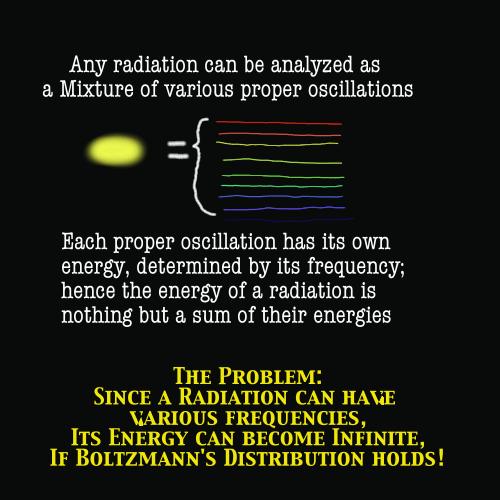

Hollow-Space Radiation or Black-Body Radiation
The history of quantum theory begins with Planck's discovery of "energy quantum" in relation to the hollow-space radiation (another name is "black-body radiation"). But what is the hollow-space radiation, and how is this related with the overall picture of physics in the 19th century? Dr. Tomonaga's book on quantum mechanics begins with this story, and it is quite useful. Here let me insert several illustrations for a better understanding of the essential points of Tomonaga's narratives.
First of all, Planck's discovery was related with thermodynamics, in the form of statistical mechanics developed by Maxwell, Boltzmann, and Gibbs. As you may well know, according to statistical mechanics, heat is (roughly speaking) nothing but a statistical aspect of the kinetic energy of many molecules composing a gas, a liquid, or a solid. Depending on the atomic structure of the substance in question, you can calculate the specific heat of the substance, accroding to this theory: the specific heat is the quantity of heat for raising its temperature 1 degree, for a unit quantity of that substance. For such calculations, Boltzmann assumed an Equal Distribution Law: roughly, each distinct individual state has an equal energy. Since a macroscopic (statistical) state of the system is a sum of individual states corresponding to the macroscopic state, its total energy is nothing but their sum; and this suited well for many thermodynamic phenomena.
However, scientists soon discovered that we cannot extend this assumption to other phenomena, including hollow-space radiation. Notice that electromagnetic radiation was regarded as a "wave" in continuous ether, and a continuous body has infinitely many proper oscillations ("proper oscillation" means "free, unforced oscillation"). And if the Equal Distribution Law were to hold, the following equation would hold:
(1) E = fkT
where k is Boltzmann's constant and T is temperature, and f is the number of proper oscillations in a hollow-space (f = ∞) . In this case, Equal Distribution means that each proper oscillation would receive an equal amount of energy, kT, thus giving the total energy E = ∞!
Drawing on the predecessors' attempts (such as Rayleigh, Jeans, and Wien), Planck tried to find a correct law describing the energy distribution in radiation in general. See the following figures.
